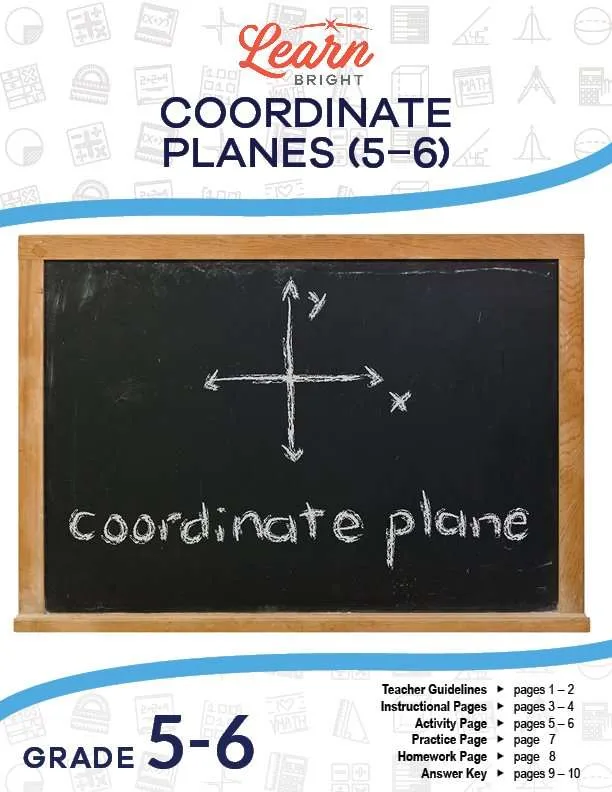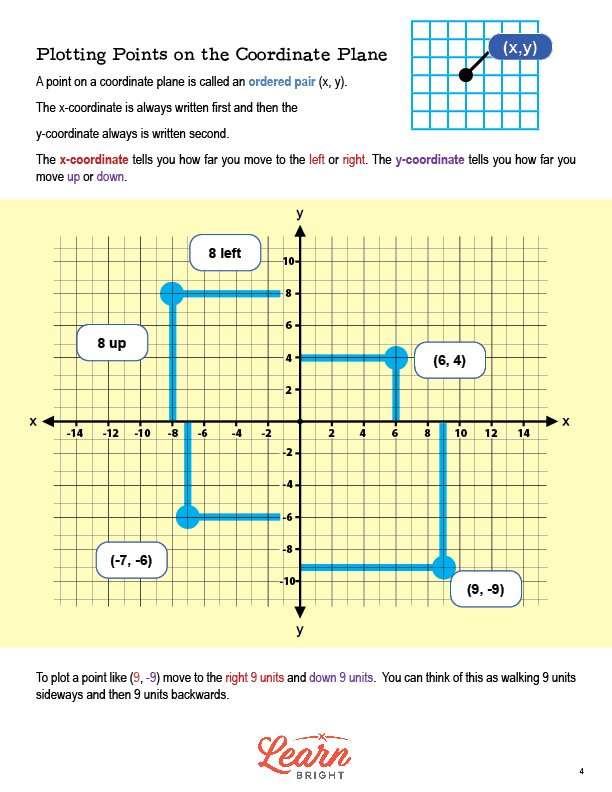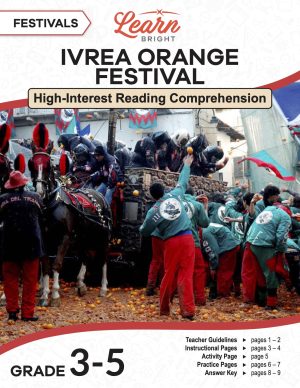Description
What our Coordinate Planes lesson plan includes
Lesson Objectives and Overview: Coordinate Planes introduces graphing and coordinate planes. At the end of the lesson, students will be able to identify the quadrants of a coordinate plane and the location of the x-axis, y-axis, and origin. They will also be able to graph points in all 4 quadrants. This lesson is for students in 5th grade and 6th grade.
Classroom Procedure
Every lesson plan provides you with a classroom procedure page that outlines a step-by-step guide to follow. You do not have to follow the guide exactly. The guide helps you organize the lesson and details when to hand out worksheets. It also lists information in the blue box that you might find useful. You will find the lesson objectives, state standards, and number of class sessions the lesson should take to complete in this area. In addition, it describes the supplies you will need as well as what and how you need to prepare beforehand. The supplies you will need for this lesson include pencils and graph paper.
Options for Lesson
Included with this lesson is an “Options for Lesson” section that lists a number of suggestions for activities to add to the lesson or substitutions for the ones already in the lesson. One optional addition to the lesson activity is to use painters tape to make a coordinate grid on the classroom floor and call out Quadrants, points or locations for students to find.
Teacher Notes
The teacher notes page includes lines that you can use to add your own notes as you’re preparing for this lesson.
COORDINATE PLANES LESSON PLAN CONTENT PAGES
Coordinate Planes
The Coordinate Planes lesson plan includes two content pages. First, it explains that coordinate planes have four quadrants created by the intersection of the x and y-axis. Points in a coordinate plane can be (positive, positive) in Quadrant I, (negative, positive) in Quadrant II, (negative, negative) in Quadrant III, or (positive, negative) in Quadrant IV.
Plotting Points on the Coordinate Plane
We call points on a coordinate plane ordered pairs (x, y). We always write the x-coordinate first and the y-coordinate second. The x-coordinate indicates how far to move to left or right, while the y-coordinate indicates how far to move up or down.
To plot the point (9, -9), we move from the center point to the right 9 units and down 9 units. The lesson includes a coordinate plane with different points marked and their ordered pairs so students can see some additional examples.
COORDINATE PLANES LESSON PLAN WORKSHEETS
The Coordinate Planes lesson plan includes three worksheets: an activity worksheet, a practice worksheet, and a homework assignment. You can refer to the guide on the classroom procedure page to determine when to hand out each worksheet.
ANGRY FLYING DINOSAURS ACTIVITY WORKSHEET
For the activity worksheet, students will play a game of Angry Flying Dinosaurs. Their goal is to be the first to throw a rock at all of their opponent’s dinosaurs, knocking them out of the sky. They will play in pairs using two coordinate grids. The lines for each of their dinosaurs must form a horizontal, vertical, or diagonal line. Each player will plot four dinosaurs on their graphs, each taking up a different number of points. They will then take turns guessing where their opponent’s dinosaurs are. They continue until one player has found all of the other player’s dinosaurs!
COORDINATE PLANES PRACTICE WORKSHEET
The practice worksheet asks students to write descriptions about the locations of each point from a list, using each word only once.
SHAPES HOMEWORK ASSIGNMENT
For the homework assignment, students will draw and label the coordinates of four shapes: a square, a triangle, a rectangle, and a pentagon.
Worksheet Answer Keys
This lesson plan includes answer keys for the practice worksheet and the homework assignment. If you choose to administer the lesson pages to your students via PDF, you will need to save a new file that omits these pages. Otherwise, you can simply print out the applicable pages and keep these as reference for yourself when grading assignments.









